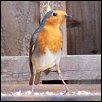
Birds in Golborne

You have to visit the countryside to see wildlife donít you? Not true! Right here in Golborne, in the heart of the inner city, cast your eyes skywards and there's wildlife galore. This neighbourhood hosts an astonishing variety of birds.
The Royal Borough of Kensington and Chelsea conducted a bird survey in 2005 and came up with a total of 55 species, many of which are to be found in and around Golborne.
In my own small garden on the Swinbrook Estate, I regularly see robins, blue tits, great tits, wood pigeons, blackbirds and wrens. Last year, for the first time, goldfinches appeared. This year a pair of these birds, with their bright red faces and yellow wing patches, are nesting in the ivy-clad wall at the bottom of my garden.
Around Golborne, Iíve seen long-tailed tits, carrion crows, magpies, swifts, jays, and even the odd rose ringed parakeet. Of these last, there is a feral population of these birds, said to be 30,000 strong; originally brought from India as pets, they now thrive in the wild.
Feral pigeons, the type you are not allowed to feed in Trafalgar Square any more, are everywhere. But donít confuse them with wood pigeons, a completely different species. Feral pigeons are the descendants of rock doves, birds that were domesticated by humans for food, for racing, and for sending messages. The feral population we now see are descended from escaped domestic birds.
Every morning youíll see a large herring gull hanging around the fishmonger on Golborne Road, some times sitting on the shop van. It makes sense; at sea the hang around fishing boats Ė in London itís fishmongers.
I always find the sight of swifts, with their screaming kree-kree cries, tremendously exciting. These summer visitors arrive in Golborne in early to mid-May, leaving again in August after raising up to three broods of chicks. They come all the way from sub-Saharan Africa each year, a return journey of six thousand miles or more.
Kestrels are another fascinating bird that you can see in Golborne; I once found a dead one on the roof of Trellick Tower. These magnificent birds of prey are at the top of their food chain, meaning they have no natural predators. You can spot this hawk by its stationary hovering flight, which is a sure sign that it is hunting for its prey of small mammals.
Where to see birds
At Meanwhile Gardens, where they have feeders, you can see wrens, great and blue tits, blackbirds, greenfinches and goldfinches. And on the Grand Union Canal adjacent to the Gardens you'll see coots, moorhens, Canada geese, mallard and tufted ducks, common terns and cormorants, and possibly even a grey heron.
Kensal Green Cemetery is another excellent place to see birds. There, you've a chance of spotting the two of the three species of woodpecker resident in the UK, the great spotted and the green. Look out for willow warblers, goldcrests and chiffchaffs as well.
Encouraging birds to visit your garden
If you're lucky enough to have a garden, you can encourage birds to visit by feeding them. Feeders and bird tables can be brought cheaply from garden centres, pet shops and supermarkets and stocked with peanuts or birdseed. Remember to place your feeder or bird table somewhere that cats can't reach.
If you do have a cat, it's a good idea to fit it with a bell so that it won't take birds, especially fledglings that are out of the nest for the first time. The bell should be fitted on a quick release collar that snaps open if it gets caught on a branch.
There's a new photo gallery to accompany this story, with birdlife pictures from the Grand Union Canal and
a Swinbrook Estate garden.
To find out more about the birds mentioned in this piece, visit the Royal Society for the Protection of Birds website or the British Trust for Ornithology website
Home






